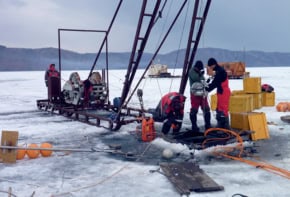Roberto Kersevan reveals life and work as a vacuum scientist at the ITER fusion project

Roberto Kersevan is a vacuum design engineer in the vacuum group working on the ITER fusion project at Cadarache in France. He is one of two deputy group leaders and is responsible for cryogenic and roughing pumps.
What were you doing before you moved to ITER, and what made you decide to move?
I was head of the vacuum group at the European Synchrotron Radiation Facility (ESRF) in Grenoble, France, after spells working on other accelerators across Europe and the US. I spent 12 years at the ESRF managing a group of 15 people plus various students and contractors. My group was responsible for maintaining the vacuum system of the 6 GeV light source, including solving any vacuum-related problems and installing new components.
I enjoyed my time at Grenoble a lot, and I have fond memories of my former colleagues and the working environment – the excitement in the control room during a night shift after some important interventions had been made, for example. I decided to join ITER for a number of reasons, the most important being that I was at a point in my career where I had the opportunity to move to a really high-profile project. For someone like me who had spent more than two decades working on accelerators, it was also a good opportunity to switch to a different field and to capitalize on the knowledge I had acquired but expand it into the field of fusion.
What is the vacuum group at ITER like?
Currently, the vacuum group consists of 10 permanent staff plus one external contractor. The group’s members come from many countries – the UK, France, Italy, Russia and Germany – and are aged between 27 and 67. The atmosphere of the group is very good; we are all friends and occasionally do fun stuff together outside of work, such as go-karting and rafting with our families.
Our “vacuum” family extends way beyond Cadarache; because of the way that the ITER project is set up, we are in close contact with the domestic agencies in the seven different member states participating in the project. We have regular meetings with them by video and via the Internet. In particular we have close ties with the agency in the US, which is based at the Oak Ridge National Laboratory, and with Europe’s Fusion for Energy, which is based in Barcelona. The US agency is responsible for, among other things, several packages concerning vacuum components, and will therefore grow in size to numbers comparable with those of our group at Cadarache.
What are the opportunities for vacuum scientists at ITER?
There are many. ITER’s vacuum system will be the most complex ever built. It may not have the biggest volume or longest span, but it encompasses the gamut of vacuum technology’s flow regimes, temperatures and pumping arrangements, all in a harsh environment. It needs state-of-the-art vacuum solutions, some of them never attempted at a project of ITER’s size and complexity. Pretty exciting stuff.
Can you describe a typical “day in the life” of an ITER vacuum scientist?
For the time being, there is a lot of design and conceptual work, including writing technical specifications for supplier contracts. I am currently working on the characterization of tritium permeation, the design of a cryogenic vacuum compressor and the design of tritium-compatible dust filters. I am also doing some computer modelling of ancillary vacuum systems using a Monte Carlo simulation code. Some of my time is spent browsing and reading the vast literature on fusion science and technology in order to understand more about ITER as a whole. I also read many papers on the subject of energy in general, including energy policy and climate change, which ties in to ITER’s primary aim of developing clean, abundant energy. However, all this will soon change. When on-site installation begins, all of us in the group will have to spend a considerable amount of our time following up on the fabrication, testing and delivery of vacuum components, and with their installation on the machine. I am looking forward to that.
What makes ITER such an interesting place to work as a vacuum scientist?
ITER’s vacuum system has everything a vacuum scientist could dream of: ultrahigh vacuum; low vacuum; molecular, transition and viscous flow regimes; high temperatures and cryogenic elements; small components and extra-large ones. The vacuum system also interfaces with many other sub-systems, such as superconducting magnets, thermal shields, cryostats, detritiation systems and diagnostics. However, there are some non-technical challenges, such as working in an environment where a large number of different nationalities and cultures are represented.
What opportunities are there at ITER for training and career development?
We all get training on nuclear safety and on the tools and software that are relevant to the design and analysis of the project’s vacuum systems. Our group will grow during the construction phase of the project, so there will be opportunities for all of the current members to become supervisors of smaller groups working on sub-projects.
What advice do you have for new physics graduates who want to get into vacuum research, and nuclear fusion in particular?
My advice to them is never to give up, especially in times of tight budgets, and to join a project where vacuum technology is key, such as accelerators or fusion. Industry too can offer interesting positions for a vacuum scientist, especially in the emerging field of renewable energy sources, such as solar technology, which increasingly employs vacuum techniques. The coating industry, in general, employs vacuum widely, so there are opportunities there, too. From a personal point of view, having completed my physics studies in surface science, I was already aware of the problems involved in the application of vacuum technology, but I would never have imagined that 23 years later I would still be enjoying working with vacuum. I can see that people who are not familiar with it might think of it as a “second tier” physics subject – mostly the application of 19th- and early 20th-century physics – but its relationships with modern physics are many: materials, surface science and nanotechnology to name just a few.
What next and where for you after ITER?
I am now 50 and with a “first plasma” at ITER scheduled for not earlier than 2019, this job could easily be my last. But I always bear in mind the fact that ITER employees only have five-year contracts, which obviously can be renewed but one can never be sure. Ideally, I’d like to have the opportunity to pass on to others the knowledge I have acquired over the past 23 years, tutoring and helping them to learn faster than I was able to do at the beginning of my career. I haven’t ruled out the possibility that some day I may join a different project, but, for now, my place is here at ITER.



